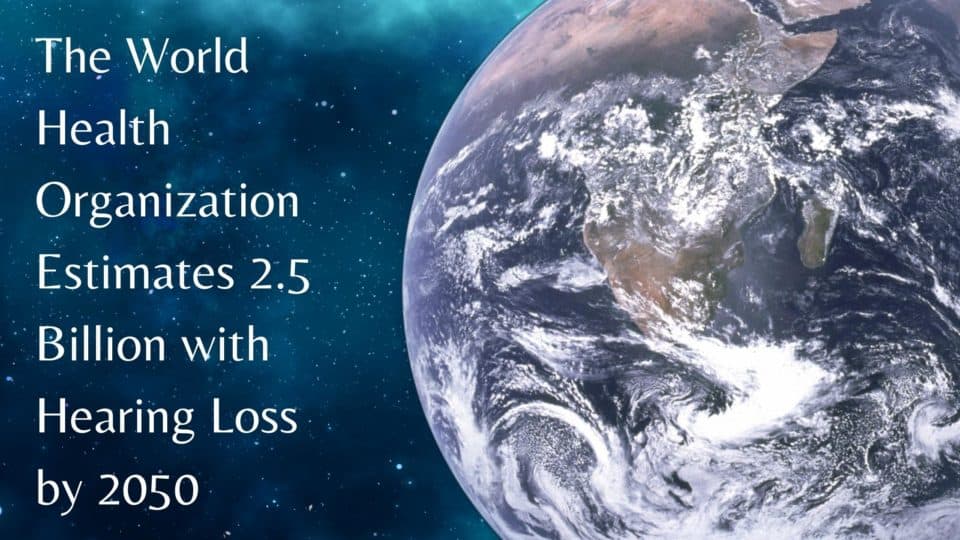- A Closer Look at Common Myths About Hearing Loss - May 7, 2024
- The Impact of Pets on Emotional and Hearing Health - April 26, 2024
- Strategies for Coping with Single-Sided Deafness - April 16, 2024
If you are living with hearing loss, you are not alone. The World Health Organization projects that there are currently an estimated 1.5 billion people living with hearing loss worldwide. The National Institute on Deafness and Other Communication Disorders (NICDC) projects that in the United States alone, there is an estimated One in eight people (13 percent, or 30 million) aged 12 years or older who have hearing loss in both ears. Now, in a startling report released in March 2021, WHO) warns that these statistics are projected to grow rapidly. In fact, by 2050, (less than thirty years) the number of people worldwide living with hearing loss could nearly double to 2.5 billion. With this report WHO hopes to highlight the importance of prevention and treatment on a global scale.
Causes of a Projected Increase in Hearing Loss
WHO’s prediction means that in less than three decades 1 in 4 people potentially could be living with hearing loss. This report is released as a wakeup call to address hearing loss on a institutional level across the planet. It hopes to raise awareness around causes of hearing loss and advocate for sound limits on technology and in workplaces.
Common Misconceptions
Part of what may cause this continuous rise in hearing loss are misunderstanding around what may cause hearing loss and how to prevent and treat it. For instance, it is common knowledge that sound can reach levels loud enough to damage hearing but while some may wear earplugs at work or while using a lawn mower, there are several less obvious sources. For instance, highway traffic can average around 90 dB on a loud day- which can contribute to permanent damage in under an hour. Another common source of noise induced hearing comes from headphones connected to personal listening devices. The safe level for listening is below 85 dB. However, headphones have the potential to produce decibels between 100-110 dB, loud enough to start damaging the ears in under 15 minuets. Due to the long hours that people listen to headphones, younger generations are experiencing higher rates of hearing loss, than ever before.
Lack of Access to Services
Hearing loss is an underestimated condition affecting communication, relationships, awareness of space, mobility, cognitive functioning, chronic depression and more. The longer people put off addressing hearing loss the worse these side effects become. However, hearing care service are rarely covered by insurance providers in the US causing people to pay out of pocket to get the treatment they could deeply benefit from. This keeps millions of people who could benefit from hearing aids from acting around their hearing. Worldwide this problem continues, with lack of treatment readily available and affordable. Globally nearly 78% of countries have less than one ENT specialist per million population and 93% have less than one audiologist per million population.
Global Limits on Noise and Chemical Exposure
To fight the growing risk of hearing loss in the impending future WHO recommends changes on institutional levels. This includes limits on Smartphones to inhibit noise induced hearing loss and limits on the sound of at home appliances. Besides damage caused by noise there are several other causes of hearing loss which are commonly unrecognized such as impact to the head, ear infection and exposure to harmful chemicals. In fact, a recent Taiwanese study recorded the effects of exposure to carbon monoxide (CO) and nitrogen dioxide (NO2) and found it was a major risk for permanent hearing loss. They noted that the higher the exposure, the greater the risk for hearing loss, leaving poorer countries and areas of the US at a greater risk for damage.
Tips to Protect Hearing Health
Stopping the effects of global hearing loss begins with you. Practice safe listening practices and don’t hesitate to educate the people in your life about how they too can protect their hearing into the future. Whenever you are at risk for hearing loss, don’t hesitate to wear hearing protection. This could be foam earplugs, custom molded earplugs, or protective headphones. If you are ever in doubt of a sound level being too loud, there are free apps available on most smartphones which can measure the decibel level everywhere you have service. If you do suspect you have a hearing loss address it today. Schedule a hearing test and join the fight to reduce the effects of hearing loss on a global level. It starts with you!

